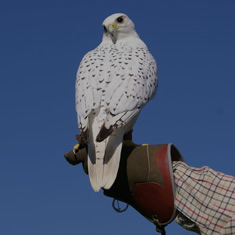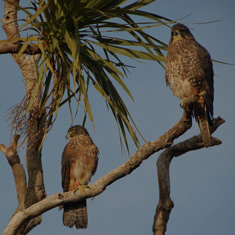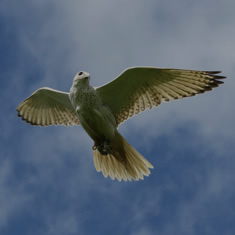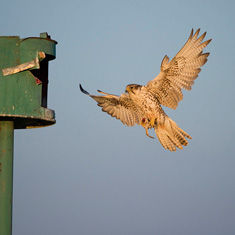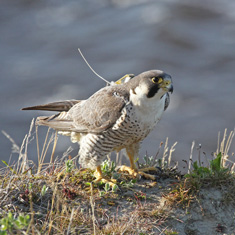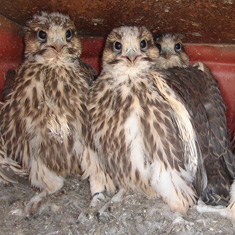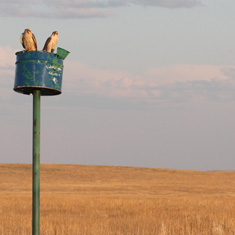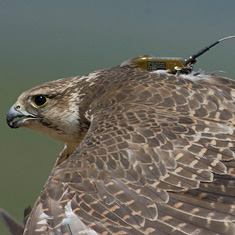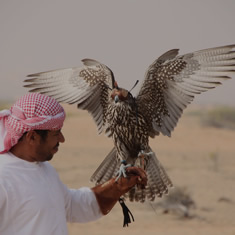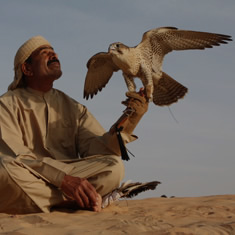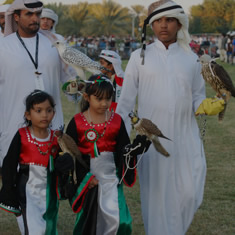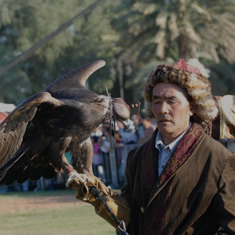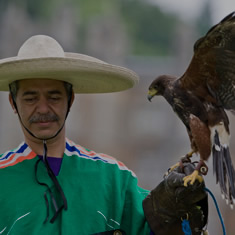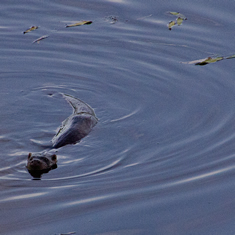- Captive breeding & research
Use in Falconry
Over the past forty years, falconers have succeeded in captive breeding all the main species of birds of prey used in falconry. Now many have been bred to several generations. In some countries falconers rely entirely on captive-bred birds.
In the Middle East, captive-bred birds are becoming more popular in the Gulf countries. Saudi falconers are more conservative and still prefer wild-caught birds. Captive-bred birds are more adjusted to captivity, have fewer parasites and diseases, and moult better. They can also be bred from selected bloodlines of proven hunters, and for preferred colours or hybrids. See the 2004 Hybrid Discussion Paper for more information. On the other hand, because they have little experience of hunting for themselves, their training is more intensive than for wild-caught birds. EAD has produced a film in Arabic on Training the Captive-bred Falcon to help falconers succeed in training these birds. This is a practical way of reducing the demand for wild-caught birds at a time when wild populations are under pressure.
The main falcon breeders are in the Gulf, Germany, UK, Russia and North America. Some of these breeders are registered with CITES as commercial breeders. The numbers of birds imported and exported can be obtained from CITES records. The main species of falcons being bred are pure-bred Saker Falcons, Peregrines and Gyrfalcons or, more commonly, hybrids between these species. Birds are bred by natural pairing or by artificial insemination. Films and books are available on captive breeding falcons.
Detailed data on eggs and incubation are scarce. We have analysed data (1984-2000) covering 432 saker eggs, 326 peregrine, 419 New Zealand Falcon, 40 Gyr, 132 Gyr/saker, and 67 Gyr/saker/saker from 70 females. We also have data for about 1600 falcon eggs from the years 2001-2004. The standard parameters measured include length, breadth, weight changes, embryonic development, type of incubation, parental ID, parental age, fertility, clutch sizes, hatchability, growth rate and ID of chick and mortality factors. Some of these data have been provided to bona fide research organisations for studies of egg shell structural changes, egg composition, turning rates and incubation regimes. We have also used some of the eggs for development by Brinsea for their contact incubator system. We have also supplied live saker eggs to the Central Science Laboratories to grow live cell lines for research into falcon virology.
Conservation and Research
- Raptor Conservation
- The Peregrine Falcon
- Mauritius Kestrel
- Red Kite Conservation
- New Zealand Falcon Conservation Project
- Migration and Movements of Saker Falcons
- Falcon Genome Project
- Electrocution of Birds of Prey
The Saker Falcon
- The Saker Falcon
- Description
- Taxonomy
- Breeding Distribution
- Breeding Population Estimates
- Wintering Distribution
- Habitat
- Hunting and Diet
- Breeding and Biology
- Migration
- Conservation Status
- Conservation Threats
- Sustainable Harvest
- Conservation overview (HH Sheikh Zayed)
- Captive breeding & research
- Bibliography
- Satellite Tracking
- Reintroduction in Bulgaria
- Reintroduction in Bulgaria
- Mongolian Artificial Nest Project Information
- Mongolian Artificial Nest Project Articles

